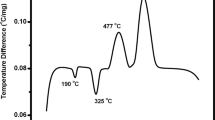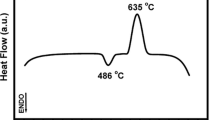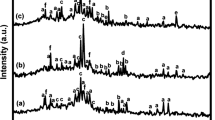Abstract
Glasses composed of multi-oxides (P2O5–B2O3–SiO2 together with Na2O and CaF2 and doped with either ZnO, CuO or Ag2O were prepared by melting- annealing technique controlled thermal heat–treatment process through two–step regime was carried for samples from the parent glasses to convert them to their corresponding glass–ceramic derivatives. Characterization of the bioactivity behavior of glass–ceramics was analyzed by FTIR spectroscopy and SEM investigations. The IR spectra for samples before and after immersion in phosphate solution reveal interfering or mixed PO4, BO3, BO4 and SiO4 groups reflecting their characteristic vibrational peaks which are located mostly within the region 400–1700 cm−1. SEM investigations were carried out for the surfaces of the glass–ceramics before and after immersion in phosphate solution. X-ray diffraction data for the glass–ceramic reveal crystalline phases formed. SEM after immersion, reveals nodular or rounded–shaped microcrystals which are characteristic for hydroxyapatite and combining the generation of the far–IR splitted band due to the same phase.
Similar content being viewed by others
Change history
06 October 2020
A Correction to this paper has been published: https://doi.org/10.1007/s12633-020-00752-3
References
El-Meliegy E, van Noort R (2012) Lithium disilicate glass ceramics, glasses and glass ceramics for medical applications. Springer, pp 209–218
Hench LL, Splinter RJ, Allen WC, Greenlee TK (1971) Bonding mechanisms at the interface of ceramic prosthetic materials. J Biomed Mater Res 5(6):117–141
Hench LL (2015) Opening paper 2015-some comments on bioglass: four eras of discovery and development. Biomed Glas 1(1)
Jones JR, Brauer DS, Hupa L, Greenspan DC (2016) Bioglass and bioactive glasses and their impact on healthcare. Int J Appl Glas Sci 7(4):423–434
Hench LL (1991) Bioceramics: from concept to clinic. J Am Ceram Soc 74(7):1487–1510
Hench LL (2006) The story of Bioglass®. J Mater Sci Mater Med 17(11):967–978
Knowles JC, Franks K, Abrahams I (2001) Investigation of the solubility and ion release in the glass system K2O–Na2O–CaO–P2O5. Biomaterials 22(23):3091–3096
Monem AS, ElBatal HA, Khalil EMA, Azooz MA, Hamdy YM (2008) In vivo behavior of bioactive phosphate glass-ceramics from the system P 2 O 5–Na 2 O–CaO containing TiO 2. J Mater Sci Mater Med 19(3):1097–1108
Liang W, Rahaman MN, Day DE, Marion NW, Riley GC, Mao JJ (2008) Bioactive borate glass scaffold for bone tissue engineering. J Non-Cryst Solids 354(15–16):1690–1696
Jung SB, Day DE (2009) Conversion kinetics of silicate, borosilicate, and borate bioactive glasses to hydroxyapatite. Physics and Chemistry of Glasses-European Journal of Glass Science and Technology Part B 50(2):85–88
Abdelghany AM, ElBatal HA, EzzElDin FM (2012) Bone bonding ability behavior of some ternary borate glasses by immersion in sodium phosphate solution. Ceram Int 38(2):1105–1113
Ouis MA, Abdelghany AM, ElBatal HA (2012) Corrosion mechanism and bioactivity of borate glasses analogue to Hench’s bioglass. Process Appl Ceram 6(3):141–149
Cook L, Mader KH (1982) Ultraviolet transmission characteristics of a fluorophosphate laser glass. J Am Ceram Soc 65(12):597–601
Duffy JA (1997) Charge transfer spectra of metal ions in glass. Phys Chem Glasses 38(6):289–292
Möncke D, Ehrt D (2004) Irradiation induced defects in glasses resulting in the photoionization of polyvalent dopants. Opt Mater 25(4):425–437
Ehrt D (2015) Phosphate and fluoride phosphate optical glasses—properties, structure and applications. Physics and Chemistry of Glasses-European Journal of Glass Science and Technology Part B 56(6):217–234
El Batal F, El Kheshen A, Azooz M, Abo-Naf S (2008) Gamma ray interaction with lithium diborate glasses containing transition metals ions. Opt Mater 30(6):881–891
Bamford CR (1977) Colour generation and control in glasses, Part of a collection of research on crystalline glazes donated (c. 1990) to CSAD by CI Brown. See Shelf 8, Boxes 5, 6, 7, Elsevier
ElBatal HA, ElMandouh ZE, Zayed HA, Marzouk SY, Elkomy GM, Hosny A (2013) Gamma rays interaction with copper doped lithium phosphate glasses. J Mol Struct 1054:57–64
Abdelghany AM, ElBatal HA, EzzElDin FM (2015) Influence of CuO content on the structure of lithium fluoroborate glasses: spectral and gamma irradiation studies. Spectrochim Acta A Mol Biomol Spectrosc 149:788–792
Paul A (1990) Chemistry of glasses. Academic Press
Kokubo T, Hayashi T, Sakka S, Kitsugi T, Yamamuro T (1987) Bonding between bioactive glasses, glass-ceramics or ceramics in a simulated body fluid. J Ceram Soc Jpn 95(8):785–791
Oh SH, Choi SY, Lee YK, Kim KN (2001) Research on annihilation of cancer cells by glass-ceramics for cancer treatment with external magnetic field. I. Preparation and cytotoxicity. J Biomed Mater Res 54(3):360–365
Kokubo T, Ito S, Sakka S, Yamamuro T (1986) Formation of a high-strength bioactive glass-ceramic in the system MgO-CaO-SiO 2-P 2 O 5. J Mater Sci 21(2):536–540
Efimov AM (1997) IR fundamental spectra and structure of pyrophosphate glasses along the 2ZnO· P2O5–2Me2O· P2O5 join (Me being Na and li). J Non-Cryst Solids 209(3):209–226
Abdel-Kader A, Higazy AA, Elkholy MM (1991) Compositional dependence of infrared absorption spectra studies for TeO 2-P 2 O 5 and TeO 2-P 2 O 5-Bi 2 O 3 glasses. J Mater Sci Mater Electron 2(3):157–163
Moustafa YM, El-Egili K (1998) Infrared spectra of sodium phosphate glasses. J Non-Cryst Solids 240(1–3):144–153
Wong J, Angell CA (1976) Glass: structure by spectroscopy. M. Dekker, New York
Husung RD, Doremus RH (1990) The infrared transmission spectra of four silicate glasses before and after exposure to water. J Mater Res 5(10):2209–2217
Abo-Naf SM, El Batal FH, Azooz MA (2003) Characterization of some glasses in the system SiO2, Na2O· RO by infrared spectroscopy. Mater Chem Phys 77(3):846–852
Tarte P (1964) Identification of li-O bands in the infra-red spectra of simple lithium compounds containing LiO4 tetrahedra. Spectrochim Acta 20(2):238–240
Condrate RA (1972) Introduction to glass science, 105. Plenum Press, New York
Ahmed MM, Abd-Allah WM, Omar AE, Soliman AAF (2020) The dual effect of copper and gamma irradiation on chronic wound healing of nanobioactive glass. J Inorg Organomet Polym Mater:1–12
ElBatal HA, El-Kheshen AA, Marzouk MA, Ghoneim NA, ElBatal FH, Ouis MA, Fayad AM, Abdelghany AM (2020) In vitro bioactivity of silicophosphate glasses doped with ZnO, SrO or CuO. Journal of Theoretical and Applied Physics:1–11
Al-Rashidy ZM, Omar AE, Abd El-Aziz TH, Farag MM (2020) In vivo bioactivity assessment of strontium-containing soda-lime-borate glass implanted in femoral defect of rat. J Inorg Organomet Polym Mater
Acknowledgements
The authors extend their appreciation to the Deanship of Scientific Research at King Khalid University for funding this work through research groups program under Grant number R.G.P.2/33/40.
Author information
Authors and Affiliations
Corresponding author
Additional information
Publisher’s Note
Springer Nature remains neutral with regard to jurisdictional claims in published maps and institutional affiliations.
Rights and permissions
About this article
Cite this article
El Batal, H.A., Azooz, M.A., Ibrahim, M.M. et al. Bioactivity Behavior of Multicomponent (P2O5 –B2O3- SiO2-Na2O-CaF2) Glasses Doped with ZnO, CuO or Ag2O and their Glass-Ceramics. Silicon 13, 1813–1823 (2021). https://doi.org/10.1007/s12633-020-00571-6
Received:
Accepted:
Published:
Issue Date:
DOI: https://doi.org/10.1007/s12633-020-00571-6




